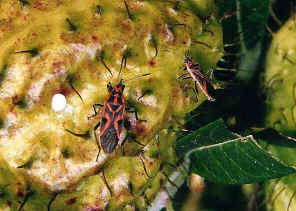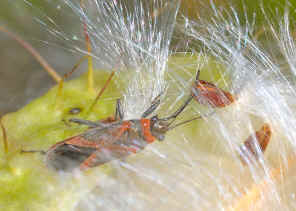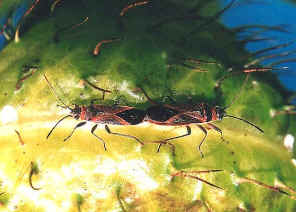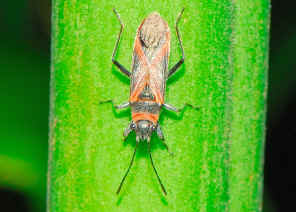Common Small Milkweed Bug - Arocatus rusticus
Family Lygaeidae
This page contains pictures and information about Common Small Milkweed Bugs that we found in the Brisbane area, Queensland, Australia. The bugs are also known as Swan Plant Seed Bug.

- Body length 9mm
- The Common Small Milkweed Bug adults have the elongated parallel sided body and orange-red with dull black colours. Head is large and triangular. Their antennae and legs are black in colour. They have relatively large eyes on distinct stalks. The thorax is half orange and half dull black. The bugs run quickly along stems and leaves of host plants.
-



- Nymph
- We found quite a number different red bug species on the Milkweed plants. The Large Milkweed bugs, with black patterns on orange colour, larger in size. This Small Milkweed Bugs have no patterns on wings and thorax, a bit smaller in size. They just stayed together peacefully sucking the juice from the Milkweed plants.
-



- This species is the most common in Brisbane among the four Small Milkweed Bugs we found. When we found the other species, we usually found this species on the plant as well.
-



- The nymphs are black in colour with bright red abdomen. The adults and nymphs found shelter in large numbers on and around the Milkweed seed pockets.



- The nymph life style is not much different from the aphids. The famous Wanderer Butterflies are not eatable since their caterpillars eat the toxic milkweed plants and store the toxic in body. It is logical to assume that those bugs are not eatable too. This is no wonder that both the Milkweed Bugs have the warning colour patterns.



- Notice their sucking mouths, the adults and nymph suck juice from the Milkweed plants. The Milkweed plants is supposed to evolved the toxic juice to against the plant-eater. However, once the insects evolved the mechanisms to overcome the toxic and store the toxic in their own body, the bugs themselves become not eatable too. The toxic host plants become their paradise. They feed freely and openly on the plants without fear of predators. The only thing they have to do is to further evolve the warning colour to warn-off the predators.
-


- At night, the Milkweed Bugs family hiding inside the milkweed seed pocket. When disturbed, they come out and run away. Some of them quickly drop to the ground.


- Adults and nymphs can be found on Monkey Rope (Parsonsia straminia), Red-headed Cotton Bush (Asclepias currasavica), Swan Plant (Asclepias fruiticosa and Asclepias physocarpa). We have more pictures and information of those host plants in the Wanderer Butterfly and Australian Crow Butterfly pages.



- It seems that this Small Milkweed Bug is even more abundant on the Monkey Rope seed pods.



- Nymph
- Reference:
- 1. Swan plant seed bug, Arocatus rusticus (Stål) - A guide to common invertebrates of New Zealand, Manaaki Whenua - Landcare Research, Clunie, L. and Jacob, H. 2008.
- 2. A taxonomic revision of the Lygaeinae of Australia (Heteroptera: Lygaeidae) - Slater, A., University of Kansas science bulletin, v. 52(8,i.e.9) p. 301-481, 1985.
